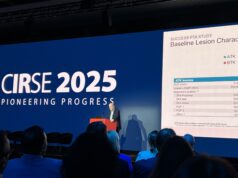
An ad hoc, two-year analysis of the EffPac study found no signal of increased risk of long-term mortality, nor any adverse events, within two years of drug-coated balloon (DCB) angioplasty using a Luminor-35 device (iVascular). This was the conclusion presented by Ulf Teichgräber (University Hospital Jena, Jean, Germany) at the 2020 meeting of the Cardiovascular and Interventional Radiological Society of Europe (CIRSE; 12–15 September, virtual).
Teichgräber is the principal investigator of the EffPac trial, a prospective, randomised controlled trial initiated by the federal authorities in Germany, and conducted at eleven study sites, that compares the paclitaxel-coated Luminor balloon with plain balloon angioplasty in the femoropopliteal artery segment of patients with peripheral arterial disease (PAD).
The primary efficacy endpoint of this study was late lumen loss at six months; secondary endpoints included primary patency, freedom from target lesion revascularisation (TLR), Rutherford category, ankle-brachial index, and quality of life score. All-cause mortality and target limb amputation were assessed as the primary safety endpoints.
Just published in Radiology, Teichgräber described to the CIRSE audience how he and his team conducted an ad hoc, two-year review of mortality and morbidity following DCB angioplasty in EffPac patients. The two-year follow-up of the EffPac trial was in fact completed in February 2019, but another study cast its shadow over the results. Konstantinos Katsanos (Patras, Greece) et al published a meta-analysis in the Journal of the American Heart Association (JAHA) in December 2018 that found an increased association between late mortality risk and paclitaxel use in the femoropopliteal arteries. “Numerous public debates about the safety of paclitaxel-coated balloons were triggered”, Teichgräber recalled.
This led the Federal Institute for Drug and Medical Devices in Germany (in German: Bundesinstitut für Arzneimittel und Medizinprodukte; BfArM) to request a formal hearing on mortality of all ongoing studies concerning paclitaxel use in the peripheral arteries.
While the EffPac trial could not confirm a correlation between paclitaxel application and all-cause mortality—there was one death in the DCB arm, out of a total of 82 patients, and seven out of 85 in the plain angioplasty arm—a lot of patients were lost to follow-up.
In total, the EffPac trial randomised 171 patients into two arms: those treated with the Luminor DCB (85 patients), and those who received plain angioplasty (86 patients). At 24 months, 60 patients were left in the DCB group, and 56 in the plain angioplasty group, due to a lack of follow-up in nearly one third of randomised patients. This represented a discontinuation of 25 patients in the DCB arm, and 30 patients in the plain angioplasty arm.
Under entreaty from the BfArM, Teichgräber set out to find those EffPac participants lost to follow-up in order to gain further information on two-year mortality rates with paclitaxel devices.
“Paclitaxel showed a very low [mortality] risk ratio of only 0.15 compared to other trials, meaning there is no correlation of all-cause mortality associated with Luminor balloons,” Teichgräber inferred from their results. “Another interesting aspect [to look at] is cause of death,” he said. “The only case of death in the DCB group was due to multiple comorbidities, which were hardly associated with the application of paclitaxel.” Patients in the plain balloon angioplasty cohort died of heart failure, sepsis, cholangiocarcinoma, respiratory failure, and suicide. “A correlation between paclitaxel and cause of death is [therefore] quite unlikely,” Teichgräber concluded.
The total number of adverse events per patient was higher in the DCB group than in the plain balloon angioplasty group, though this difference was not statistically significant (3.2±2.8 vs. 2.9±2.6; p=0.59). The proportion of patients who experienced any adverse event was slightly higher in the plain angioplasty arm of the study, but again, this difference was not statistically significant (88.5% vs. 86.5%, respectively; p=0.81). “So there is no real difference in adverse events between both groups,” Teichgräber summarised. Except for serious malignancies, there were no significant between-group differences in the incidence of adverse event types.
Summing up, Teichgräber said: “I believe that such an ad hoc analysis on discontinued patients in randomised controlled trials gives us a full picture on all-cause mortality for our follow-up patients.
“As we do not have a class effect between different DCB products, with our ad hoc analysis we can only give information on Luminor balloons, and their coating technology. Therefore, it is important that other trials, with other DCB products, go the same way as we did with EffPac, and assess what happened to their lack-of-follow-up patients, and [see] if they could show equivalent results of all-cause mortality in their full cohort.”










